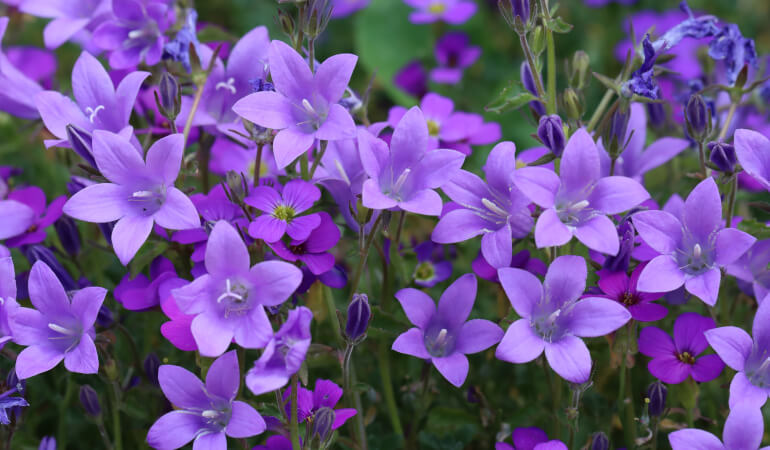
Ground cover plants provide a dense carpet of beautiful foliage and flowers that can be an amazing addition to simple and elegant gardens while greatly supporting pollinators, such as hummingbirds and bees. These low-growing plants usually spread quickly and are generally easy to maintain.
They can be positioned around taller plants, greatly complimenting their flowers, around trees and taller shrubs for an extra “wow” effect, or alternatively, on areas that are difficult to maintain, such as slopes. You can even create a picturesque lawn from some varieties of low-growing plants!
Ground cover plants can greatly help if you have issues with weed growth, as they lock in nutrients and soil moisture. They also work great for soil erosion since their roots hold things together, ensuring that soil doesn’t detach from the ground on windy and/or rainy days.
We have many more great things to say about ground cover plants, so In this article, we will reveal some of the best varieties to grow in a UK garden with care tips for each one of them. So let’s find out the plant that is most suitable for your outdoor area!
Evergreen ground cover plants
The huge benefit of evergreen low-growing plants is that they remain lush and thrive in the colder months, while others do not possess the strength to withstand frost. Another huge benefit is their low maintenance. So if you are looking for garden plants that provide colour and texture without requiring a lot of care, here are a few options.
Creeping Phlox (Phlox Subulata)

Also known as “Moss Phlox”, this evergreen or semi-evergreen perennial marvel captivates hearts with its resplendent carpet of mesmerising pink, fiery red, velvety purple, cerulean blue or pristine white star-shaped blossoms that gracefully show their radiant beauty during springtime.
Moreover, Creeping Phlox can be very beneficial for attracting pollinators in your garden. It requires very little maintenance and can be a great feature for rock gardens, edging and border fronts.
With an almost serpentine grace, Creeping Phlox effortlessly thrives in various types of soils, demonstrating its remarkable adaptability. Still, the ideal soil is not merely damp but rather a well-draining ground, meticulously crafted to provide optimal conditions for its roots to flourish and eagerly absorb life-giving nutrients.
Despite its ability to endure partial shade, this plant truly thrives when positioned in an open and sunny location.
Make sure to provide the plant with extra water during hot and dry weather. A bonus tip for boosting Moss Phlox’s beauty is to cut the stems back after blooming – this will promote the growth of another batch of flowers.
Angelina Stonecrop (Sedum Rupestre “Angelina”)
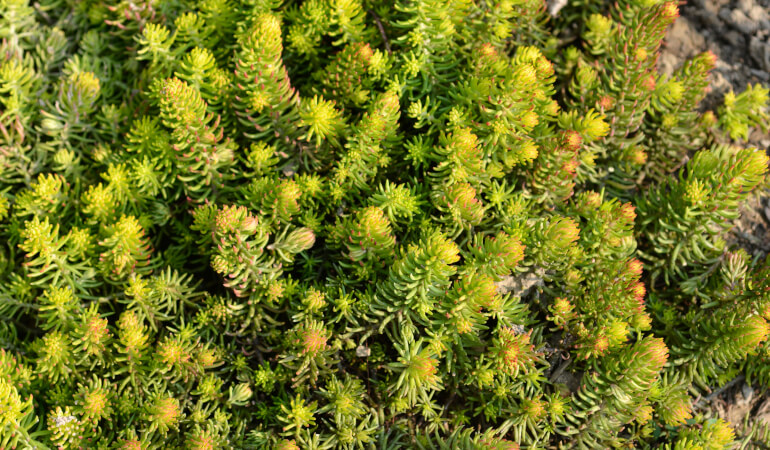
Looking to spice up your garden game? Angelina Stonecrop could be the sassy succulent you’ve been searching for that can easily thrive in pretty much any setting.
The Angelina Stonecrop is classified as an evergreen perennial, with thick stems and leaves. It produces attractive bunches of petite, star-shaped yellow blooms.
During spring, the plant’s leaves have a vibrant yellow hue that transforms into a yellow-green shade during summer. As autumn approaches, the leaves of the Angelina Stonecrop turn a striking blend of red and orange, providing year-round visual appeal.
This ground cover plant doesn’t require as much maintenance. Still, ensuring optimal growth conditions is essential for this plant’s success. It flourishes in well-drained soil with a neutral pH level, exhibiting remarkable adaptability to varying light conditions.
While it enjoys full sunlight, it also demonstrates remarkable tolerance to partial shade. Regular watering is crucial during the initial planting stage, but once firmly established, Angelina Stonecrop demonstrates a remarkable drought-tolerant nature.
Japanese Spurge (Pachysandra Terminalis)

The Japanese spurge is a resilient perennial plant with shiny clusters of deep green leaves that become yellow during the winter. While it does produce white blooms in the spring, it is primarily sought after for its durable foliage.
This plant is a great choice for filling in large open spaces, filling gaps between deciduous trees and shrubs, or planting in areas where other plants struggle to grow. It will add a vibrant and attractive touch to your outdoor space throughout the year.
This versatile plant can be successfully cultivated in a range of lighting conditions, exhibiting remarkable adaptability. While it demonstrates a distinct preference for full or partial shade, it can also endure harsher, more radiant sunny environments.
The soil that Japanese spurge does best in should be moist and well-drained. You need to water this evergreen ground cover plant only until it is established. Once it develops, it needs little to no maintenance.
Perennial ground cover plants
Perennial ground-covering varieties that form good-looking carpets can also be put to great use in your garden. In a general sense, most of them are considered low-maintenance and have the ability to last long if properly taken care of.
And last but not least, they are perfectly capable of providing colour and interest where other plants struggle to thrive.
Bellflower (Campanula)

Low-growing and forming in clumps, Bellflowers can be used to add colour and charm to raised beds, gravel gardens, or in front of a sunny garden border. This perennial produces either blue, purple, white or pink flowers that are shaped like little bells from June to August.
Bellflowers prefer either full sun or partially shaded areas and are able to be cultivated either indoors or outdoors. This remarkably resilient plant has the unique ability to flourish in a wide spectrum of soil conditions. Nevertheless, for optimal growth and vitality, it is highly recommended to select a well-draining soil characterised by low pH levels.
Water this beautiful plant regularly, ensuring the soil stays moist, especially when the weather is dry. Still be cautious not to over-water it, as this could cause root rot.
Lily of the Valley (Convallaria majalis)

This enchanting ground cover perennial, with its delicate foliage and graceful demeanour, can be an exquisite addition to a woodland garden or a shady border, adding a touch of ethereal beauty to any landscape. Another great place for Lily of the Valley is under the shaded areas of shrubs. The plant has big, oval-shaped leaves that come in pairs which makes them effective in covering the ground.
It is considered a fast-spreading plant that produces white flowers that are shaped like little bells that have a pleasant fragrance that dangles from slightly arched stems in late spring.
Lily of the Valley is a low-maintenance plant that has minimal requirements, although there are some factors to bear in mind. It is not picky about the type of soil it grows in. You can choose a clay or sandy one, but keep it moist.
This perennial ground cover plant prefers shady areas. On the other hand, it can thrive in a sunny area, but you will need to water it more frequently.
Important: Please be aware that Lily of the Valley is highly poisonous to both humans and pets due to its cardiac glycoside content. Every part of the plant is toxic, including the berries, which may look enticing to young children!
Mexican daisy (Erigeron karviskianus)
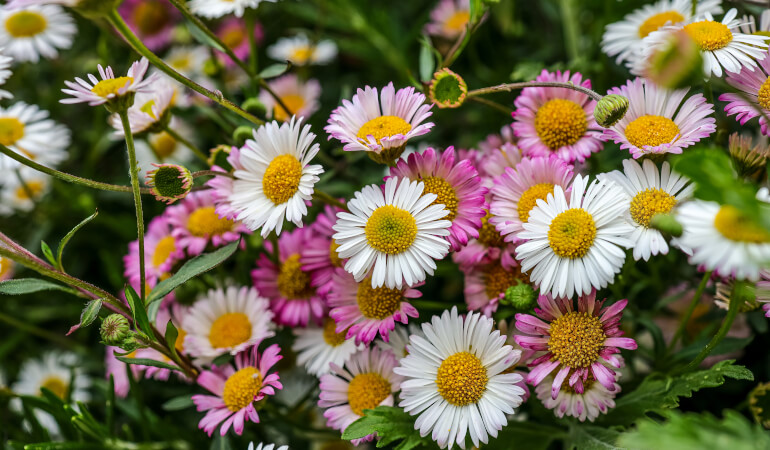
Mexican daisy, or Erigeron karviskianus is native to Mexico but can also be found in some parts of Central America and can thrive in a sunny UK garden.
It features delicate green foliage, accompanied by spectacular white daisies. As time progresses, they change their colour to pink with yellow in the centre, making the plant an interesting choice throughout its blooming phase from May to October.
The plant is suitable for people with small gardens because of its size and growth characteristics. It spreads slowly and also self-seeds.
Mexican daisy is an extremely versatile option, as it can be planted in various ways, for example, as a ground cover, behind smaller retaining walls, as a perimeter lining for garden beds, or on the sides of stone or brick steps.
What’s more, it can even grow into wall crevices and establish itself between pavement slabs.
This daisy-like perennial requires very little maintenance once developed, so you just have to water it regularly and feed it some fertiliser during the growing season. Just make sure the soil drains properly, position the plant in full sun to partial shade and water moderately once established.
The best ground cover plants to prevent weeds
Any garden can succumb to a weed infestation problem. Weeds are incredibly tough and have the ability to appear and thrive in many places. They suffocate other plants, depriving them of much-needed soil nutrition and, in more severe cases, they overcrowd them.
If you want an alternative and an environmentally-friendly solution to this common issue for most gardeners, we strongly recommend incorporating these specific ground cover plants that are excellent for preventing weed growth.
Creeping Juniper (Juniperus horizontalis / Blue Rug)
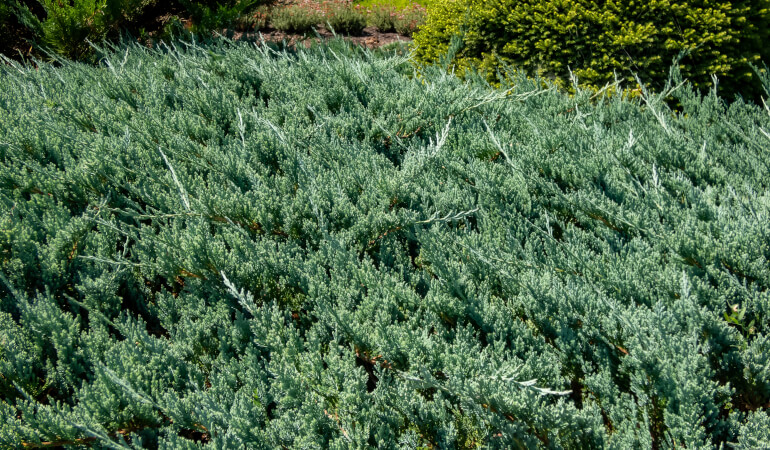
Producing a mass of feathery, green or blue-ish toned foliage, Creeping Juniper or Blue rug can easily control garden problems like soil erosion and weed growth due to its low-growing and fast-spreading nature, as well as its densely packed foliage. The plant is evergreen, providing appeal and beauty all year round.
Blue rug is also suitable for various locations such as flower beds, borders, banks, slopes, rocky areas, and near retaining walls. However, ensure that there is enough room for its growth, as it tends to spread.
To properly care for Blue rug, ensure that it is planted in well-drained soil and receives either full sunlight or partial shade.
Water it deeply, but not frequently, so it can develop strong roots. Another thing you can do is prune lightly when Spring arrives and remove any dead branches.
Ground Clover

Creating a clover lawn instead of grass has many benefits – it’s far easier to maintain, it’s environmentally friendly and easier on the pocket, as well. It’s soft foliage does a wonderful job of suppressing weed growth.
This amazing plant has the ability to transform nitrogen from the air into nitrogen that can be used by other plants. This makes Clover a natural fertiliser, which, in turn, helps greatly against weeds. You can either choose to plant Clover on its own or mix its seeds with grass ones, which will be good for traffic tolerance.
Another good thing about Clover is that it doesn’t require fertiliser or mowing. Once established, you can only water once a season, and it will still remain green and thriving. It also does well in a variety of light conditions, from full sun to partial shade.
Creeping Thyme (Thymus serpyllum)
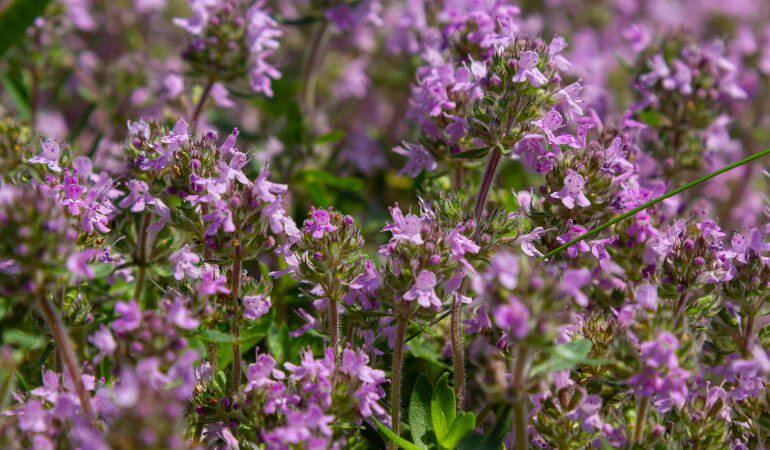
This plant, capable of reaching heights between 3 and 6 inches (7-15 cm), exhibits a remarkable ability to form a dense and aesthetically pleasing mat that displays an exceptional tolerance to foot traffic.
The leaves of Creeping Thyme are soft to the touch and emit a pleasant scent, while also having a bluish-green hue. Its blooming period occurs between June and September, showcasing delicate pink-purple flowers in a tube-like shape.
It easily attracts pollinators due to the aroma that the plant produces and its attractive colours. The plant’s low growing habit and dense carpet of foliage are also extremely efficient in weed control.
It prefers to be grown fully exposed to sunlight, in a soil with neutral pH levels. When it comes to watering – it only requires water once every 10-15 days. However, in a very hot summer, make sure to water Creeping Thyme daily.
Need a professional gardener?
Enter your postcode to view our rates and availability in your area.
For questions about the services we offer visit our main site or you can always call us at 020 3404 4881
Takeaways
- Ensure that you have enough space if you opt for the wide-spreading ground cover plants;
- Most varieties of low-growing ground cover plants are low-maintenance, making them ideal for people with tight schedules;
- They are valuable for various reasons like attracting bees and other pollinators, enhancing the esthetics of your garden and preventing weed growth;
- Hardy ground cover plants typically are able to grow and thrive in spots where other plants cannot.
